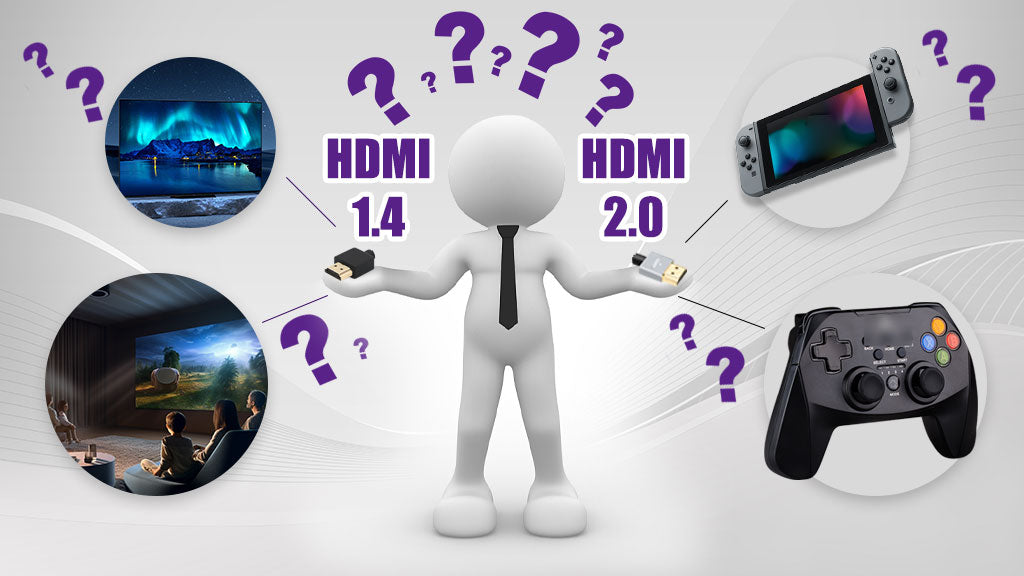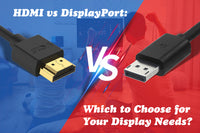Future-Proofing Your Display: HDMI 1.4 vs. 2.0
Contents [show]
HDMI is one of the most common interfaces for audio and video transmission. Many devices are equipped with HDMI ports, such as TVs and gaming consoles. Since the emergence of HDMI in 2002, HDMI has evolved in the past years and now the latest version is HDMI 2.1. HDMI 1.4 and HDMI 2.0 are popular and widely used versions in people’s daily life. We’ll further explore HDMI 1.4 and 2.0 in this article to future-proof your display.
Do You Know HDMI?
HDMI stands for High-Definition Multimedia Interface. Before the introduction of HDMI, DVI was commonly used in audio and video transmission. HDMI was later created to carry more high-quality digital audio and video with its easy plug-in and plug-out design. HDMI devices can communicate with each other, and HDMI is compatible with DVI. HDMI connectors were introduced in 2002 and have evolved from the original version to different versions.
What is HDMI 1.4?
HDMI 1.4 was released to the public on May 28, 2009. HDMI 1.4 boasts multiple upgrades compared to the former versions. It can support 4k HD resolution, which is an extraordinary achievement in the industry. There are some advantages and disadvantages of HDMI 1.4:
Pros
- First to support 4k HD resolution up to 4K × 2K (3840×2160p@24 Hz/25 Hz/30 Hz or 4096×2160p@24 Hz).
- HDMI 1.4 supports 3D video display but requires additional equipment.
- Audio Return Channel (ARC) can help deliver audio data received by TVs or other devices to AV receivers through specific cables.
Cons
- Limited by bandwidth of 10.2 Gbit/s, it cannot support 8K resolution.
-
Unable to support HDR.
![HDMI 1.4 can support 4K]()
HDMI 2.0, What Should You Know?
HDMI 2.0 is the next version of HDMI 1.4, released in September 2013. It boasts enhanced performance than HDMI 1.4. HDMI 2.0 provides higher bandwidth and better audio performance for many devices, especially 4K HD displays. HDMI 2.0 also has its advantages and disadvantages:
Pros
- HDMI 2.0 features a 60Hz refresh rate for 4K displays with 4:4:4 resolutions.
- 12-bit color provides a more high-quality video picture for users.
- Up to 32 channels of lossless audio can be processed, greatly enhancing sound performance.
- HDMI 2.0 can deliver dual streams to multiple users simultaneously, which means you can watch two HD programs on the same screen at the same time.
- HDMI 2.0 can support HDR, providing higher color saturation of the image.
- Bandwidth is up to 18 Gbps.
Cons
- Dynamic HDR is not supported.
- VRR is not supported.
- eARC is not supported.
HDMI 1.4 vs 2.0: What’s the Difference
Frames Per Second (FPS)
It is known that HDMI 1.4 and 2.0 can support 4K displays. But HDMI 1.4 can only support 4K video at a refresh rate of 24; HDMI 2.0 can achieve high-quality 4K video at 50 and 60p. So, HDMI 1.4 is suitable for just watching videos, and HDMI 2.0 is your best choice for playing games.
Bandwidth
While HDMI 1.4 has a bandwidth of 10.2Gbps, version 2.0 expands to 18Gbps, which can support 3840*2160 resolution. In addition to the upgraded resolution and frame rate, version 2.0 can also support up to 32 channels and up to 1536 KHz sampling rate in audio.
Color Depth Support
Since HDMI 2.0 owns extra bandwidth, it can support 10-bit and 12-bit color depth to transport 4K video. But HDMI 1.4 is limited to 8-bit color depth because of its bandwidth. You may be confused about the difference between 8-bit, 10-bit, and 12-bit. 8-bit color depth means it can deliver 16.7 million colors while 12-bit color depth is up to 68.7 billion colors. It is just 12-bit color depth that makes HDMI 2.0 support HDR. Thus, 2.0 has better color gradation than 1.4, and the image is more detailed and richer.
HDR Support
HDR means high dynamic range, which provides a wide range of colors and obvious color contrast in the display. HDR technology can bring users a better visual experience! Higher refresh rate and higher color depth make HDMI 2.0 support HDR, but HDMI 1.4 doesn’t support this tech. For HDR support, you need an HDMI cable with at least 18Gbps.
|
|
HDMI 1.4 |
HDMI 2.0 |
|
Maximum Resolution |
4K/30Hz |
4K/60Hz |
|
Maximum Data Rate |
10.2Gbps |
18Gbps |
|
Color Depth Support |
8-bit |
12-bit |
|
HDR |
not support |
support |
HDMI 1.4 or 2.0 for Your Daily Use
In general, the HDMI cable version should be used with devices that can support the corresponding data rate, bandwidth, and refresh rate for the best performance. HDMI 2.0 outperforms HDMI 1.4 in many aspects, so which one should you choose for your daily use?

- For gaming
HDMI 2.0 is best for 4K gaming. There is no doubt that HDMI 2.0 is a better option for gaming than HDMI 1.4 due to players’ need for Dynamic HDR, VRR, ALLM, and Free Sync. HDMI 2.0 can provide a better game experience than HDMI 1.4. HDMI 2.0 can give you a high refresh rate so you will see smooth and vivid gameplay graphics.
- For TV
You need to check your TV specification first. If your TV supports 8K and you want to get a perfect viewing experience, HDMI 2.0 can be a better choice. In addition, HDMI features enhanced HDR support, delivering richer colors and brighter highlights.
In summary, choosing HDMI 1.4 or 2.0 depends on your specific requirements and device configurations. If you primarily use your setup for casual viewing of HD content or gaming at standard resolutions, HDMI 1.4 may suffice. However, if you want to experience the best picture and sound quality, especially with 4K and 8K HDR content and high-refresh-rate gaming, investing in HDMI 2.0 cables and devices can be a better choice.
Conclusion
HDMI has been upgraded to HDMI 2.1, but it is compatible with former versions. Its backward compatibility makes it convenient for users. Compared to HDMI 1.4, HDMI 2.0 has large upgrades. If your device supports HDMI 2.0, I suggest you prioritize the HDMI 2.0 version. However, HDMI 1.4 still serves a purpose, particularly for those with older devices.
For more information on this topic, you can keep up on our blogs. While VCELINK offers general and basic information for our customers and other visitors to the website, it’s not professional advice.
FAQS
-
Can I use HDMI 1.4 on a 2.0 port?
Yes, you can. Because HDMI 1.4 and 2.0 use the same interface and connector. And HDMI 2.0 is backward compatible with HDMI 1.4.
-
Does HDMI 2.0 support 144Hz?
HDMI 2.0 can only support 1440p at 144Hz. And HDMI 2.1 can be a better choice.
-
Does HDMI Cable Impact Quality?
Yes. Length and the quality of the cable both impact quality. If the cable is too long, the signal may be lost, and if the cable is of bad quality with cheap materials, it can result in lost or damaged information.






COMMENTS